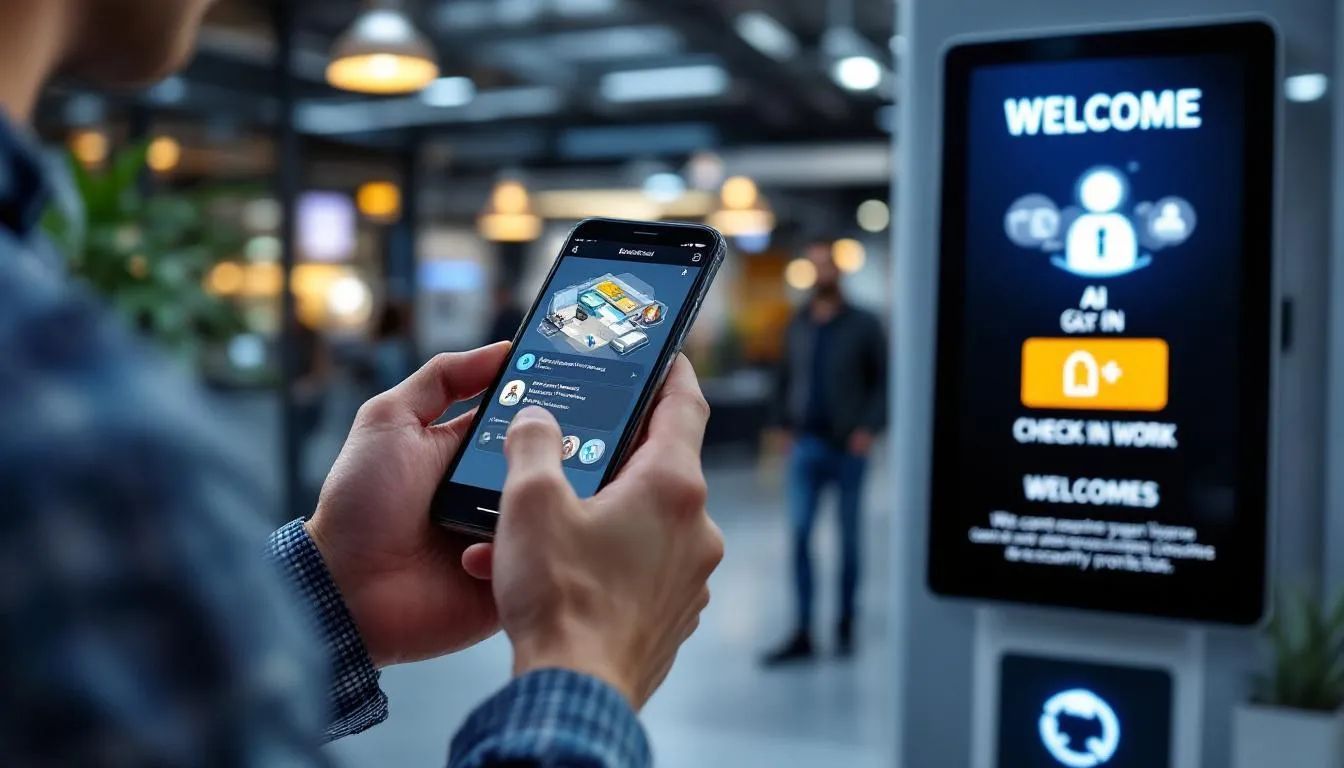Hybrid work is no longer just a trend—it's the new normal, and organizations everywhere are asking: which AI vendors provide solutions for hybrid workforce integration? If your workplace is juggling in-office and remote teams, you already know the challenges: scattered tools, uneven experiences, and the constant struggle to keep everyone connected and productive. The good news? AI-powered platforms are rewriting the rules, making it easier than ever to unify people, spaces, and data. In this guide, you’ll discover which AI vendors provide solutions for hybrid workforce integration, what to look for in a platform, and how to future-proof your workplace for whatever comes next.
1. Why AI Is Now Mission-Critical for Hybrid Workforce Integration
The post-pandemic shift from remote to truly hybrid workplaces
The world of work changed overnight in 2020, but as offices reopened, the story didn’t end there. Instead of everyone returning to their desks, most companies settled into hybrid models, blending remote and on-site work. According to Gallup, over half of U.S. employees in remote-capable roles now work in a hybrid setup. This shift created a new set of challenges: how do you ensure every employee, no matter where they are, has the same access, support, and sense of belonging?
Key pain points that AI uniquely solves (visibility, equity, automation)
Traditional tools weren’t designed for this complexity. Employees bounce between dozens of apps, support teams drown in repetitive requests, and managers lose sight of who’s thriving and who’s falling behind. AI steps in to:
- Unify Disconnected Systems: AI connects HR, IT, and collaboration tools so employees get seamless support.
- Level the Playing Field: Intelligent assistants deliver the same experience to everyone, everywhere—no more “out of sight, out of mind.”
- Automate the Mundane: From onboarding to approvals, AI handles routine tasks, freeing up your people for more meaningful work.
“AI is the connective tissue that brings fragmented hybrid workplaces together, delivering visibility, equity, and automation at scale.”
2. Setting Your Requirements: From Compliance to Culture

Security, privacy and regional regulations to tick off first
Before diving into which AI vendors provide solutions for hybrid workforce integration, start with the non-negotiables. Security and privacy aren’t just IT’s problem—they’re everyone’s. Look for platforms that:
- Offer role-based access controls and single sign-on (SSO)
- Comply with global standards (GDPR, SOC 2, ISO 27001)
- Provide clear data privacy policies and transparent data usage
Must-have features vs. nice-to-haves for global teams
Hybrid work is about flexibility, but not every feature is a must-have. Here’s how to prioritize:
Must-haves:
- Seamless integrations with collaboration tools (Slack, Teams, Outlook)
- Desk and room booking with real-time availability
- Visitor management and digital check-in
- Analytics for occupancy and engagement
- Automated onboarding/offboarding
Nice-to-haves:
- AI-powered scheduling assistants
- Digital signage and wayfinding
- Advanced customization and branding
- Wellness and engagement modules
Budgeting for total cost of ownership, not just licence fees
Don’t get caught off guard by hidden costs. Total cost of ownership includes:
- Licence or subscription fees
- Implementation and training
- Integration with existing systems
- Ongoing support and upgrades
A smart approach is to use an ROI calculator (many vendors offer them) to see how much time, space, and money you’ll save by reducing manual work and optimizing office use.
“The best solution isn’t always the one with the longest feature list—it’s the one that fits your needs, supports your culture, and delivers value over time.”
3. Which AI Vendors Provide Solutions for Hybrid Workforce Integration? A Curated Shortlist
So, which AI vendors provide solutions for hybrid workforce integration in 2025? Here’s a focused shortlist of platforms leading the way:
Moveworks: Agentic AI as the connective tissue
Moveworks stands out for its agentic AI, which doesn’t just answer questions—it reasons, plans, and takes action across your HR, IT, and collaboration systems. Employees can make requests in Slack or Teams, and Moveworks automates everything from onboarding to access management, delivering instant support at scale. With deep integrations and multi-language support, Moveworks is trusted by global enterprises to unify the hybrid experience.
Yarooms & Yarvis: Space management with conversational ease
Yarooms is a comprehensive hybrid workplace platform that covers desk booking, visitor management, analytics, and digital signage. Its AI assistant, Yarvis, lives inside Teams and Slack, making it easy for employees to schedule meetings, book spaces, or find colleagues using natural language. Yarooms shines for its Microsoft 365 integrations and ROI-focused analytics, while Yarvis takes the friction out of everyday coordination.
FM:Systems: Smart-building analytics for data-driven layouts
FM:Systems brings advanced analytics and smart-building automation to hybrid workforce integration. Its AI-driven platform uses IoT sensors to track occupancy, optimize cleaning, and adjust HVAC for comfort and efficiency. Facility managers get predictive insights to redesign office layouts, cut real estate costs, and ensure compliance—all while supporting a dynamic hybrid workforce.
Envoy & Robin: Visitor-first and AI-assisted scheduling options
Envoy is known for its intuitive visitor management and delivery solutions, but it also offers robust desk and room booking, occupancy analytics, and compliance features. Robin, meanwhile, leverages AI to recommend the best spaces, streamline check-ins, and capture employee feedback. Both platforms integrate with major calendars and collaboration tools, making them accessible and easy to adopt.
4. Head-to-Head: Feature Comparison of the Leading Platforms
Choosing which AI vendors provide solutions for hybrid workforce integration isn’t just about the brand—it’s about the fit. Here’s how the top contenders compare on what matters most:
Collaboration & comms integrations
- Moveworks: Deep integrations with Slack, Teams, ServiceNow, Workday, and more.
- Yarooms/Yarvis: Native links to Microsoft 365, Teams, Outlook, Google Workspace, and Okta.
- FM:Systems: Connects to building management and workplace tools, with IoT support.
- Envoy & Robin: Integrate with Slack, Teams, Outlook, Google, and access systems.
Onboarding/offboarding automation depth
- Moveworks: Automates provisioning, access, and training across systems—no manual chasing.
- Yarooms/Yarvis: Streamlines onboarding via booking automation and calendar syncs.
- FM:Systems: Automates space assignments and compliance tasks.
- Envoy & Robin: Simplify guest onboarding and automate check-ins, but less focus on HR flows.
Analytics and predictive insights
- Moveworks: Real-time insights on engagement, ticket resolution, and support trends.
- Yarooms/Yarvis: Occupancy, booking, and engagement analytics with ROI calculators.
- FM:Systems: Predictive analytics for space usage, cleaning, and layout optimization.
- Envoy & Robin: Occupancy and usage reports, with Robin offering employee feedback surveys.
“It’s not about picking the flashiest AI—it’s about finding the right blend of integrations, automation, and insights for your unique hybrid workforce.”
5. Implementation Roadmap: From Pilot Project to Enterprise Roll-Out
Rolling out a new AI platform for hybrid workforce integration? Here’s a proven path to success:
Phase 1: Discovery and stakeholder alignment
- Map Needs and Pain Points: Gather input from HR, IT, facilities, and employees.
- Define Success Metrics: Set clear goals (e.g., reduce booking friction, improve support speed).
- Shortlist Vendors: Focus on which AI vendors provide solutions for hybrid workforce integration that fit your needs.
Phase 2: Sandbox pilot and success metrics
- Test in a Pilot Group: Run a small-scale pilot in one location or department.
- Collect Feedback: Use surveys and analytics to measure adoption, satisfaction, and ROI.
- Adjust Workflows: Refine training, integrations, and policies based on real-world use.
Phase 3: Global scale-up and continuous optimisation
- Expand Roll-Out: Gradually scale to more locations and teams.
- Monitor and Iterate: Use analytics to identify gaps and continuously improve.
- Foster Engagement: Offer training, support channels, and celebrate quick wins.
“A phased approach builds trust, uncovers hidden needs, and ensures your AI solution delivers real value from day one.”
6. Avoiding Common Pitfalls When Deploying AI for Hybrid Work
Even the best AI platform can stumble if you don’t plan for the human side. Here’s how to avoid the most common traps:
Shadow IT and data silos that derail adoption
When employees use unsanctioned tools or create workarounds, you lose visibility and control. Prevent this by:
- Involving end-users early in the selection process
- Choosing platforms that integrate with existing tools
- Setting clear policies and communicating the “why” behind new systems
Change-management tactics that keep employees engaged
Adoption isn’t automatic. To keep your hybrid workforce engaged:
- Provide hands-on training and easy-to-follow guides
- Celebrate quick wins and share success stories
- Offer ongoing support and feedback channels
“Technology alone won’t transform your hybrid workplace—engaged people and thoughtful processes make all the difference.”
7. Future-Proofing: Emerging Trends Every Buyer Should Track
The hybrid workplace is evolving fast. Here’s what forward-thinking organizations (and the best AI vendors) are watching:
Generative AI copilots for employee self-service
AI assistants are becoming true copilots—handling complex requests, summarizing meetings, and offering proactive nudges to keep teams on track. Expect more platforms to embed generative AI for personalized, real-time support.
IoT sensors feeding real-time occupancy data
Smart sensors are making it possible to track not just who’s in the office, but how spaces are really used. This data feeds into AI platforms to optimize layouts, reduce waste, and improve employee comfort.
Ethical AI governance in distributed workplaces
As AI becomes more powerful, ethical questions grow. Leading vendors are investing in transparent algorithms, bias audits, and privacy-first design—helping organizations build trust while staying compliant.
“The future of hybrid work belongs to platforms that blend intelligence, flexibility, and ethics—empowering people to connect, create, and thrive anywhere.”
Bullet List 1: Key Benefits of AI-Driven Hybrid Workforce Platforms

- Unifies fragmented systems for a seamless employee experience
- Automates repetitive tasks, boosting productivity and engagement
- Personalizes support and resources based on role, location, and history
- Delivers actionable analytics to optimize space and costs
- Enhances security and compliance with automated processes
Bullet List 2: Must-Ask Questions When Evaluating AI Vendors
- Does the platform integrate with your current HR, IT, and collaboration tools?
- What security and privacy certifications does it hold?
- How easy is it for employees to use—especially those less tech-savvy?
- Can it scale across multiple sites and regions?
- What support and training does the vendor provide?
Ordered List: Steps to a Successful AI-Powered Hybrid Workforce Rollout
- Identify your core needs and compliance requirements.
- Shortlist vendors with proven hybrid workforce integration solutions.
- Run a pilot and measure adoption, satisfaction, and ROI.
- Refine workflows and provide training based on feedback.
- Scale up, monitor results, and continuously optimize.
“Hybrid work is about more than where people sit—it’s about creating a culture where everyone feels connected, valued, and empowered to do their best work.”
The Neroia Perspective: Building Authentic Hybrid Culture
While many platforms focus on space and process, true hybrid success is about people. Neroia stands out by nurturing workplace culture and engagement through AI-driven recommendations for small-group activities—helping colleagues effortlessly discover shared interests and build authentic connections. By integrating seamlessly with your existing systems and prioritizing privacy, Neroia is the flexible, user-centric solution for organizations that want to go beyond logistics and cultivate a vibrant, connected community.
Conclusion: Choosing the Right AI Partner for Hybrid Workforce Integration
So, which AI vendors provide solutions for hybrid workforce integration? The answer depends on your size, needs, and vision—but the leaders are clear: Moveworks, Yarooms (with Yarvis), FM:Systems, Envoy, and Robin top the shortlist, each offering unique strengths. To future-proof your hybrid workplace, look for platforms that unify systems, automate support, deliver actionable insights, and foster real human connection.
In the end, the best solution is the one that fits your people, your culture, and your goals. As you explore your options, don’t forget that platforms like Neroia can help you build not just a smarter workplace, but a more connected and inspired one—where every employee, everywhere, can thrive.
“The future of work is hybrid, intelligent, and deeply human. Choose your AI partners wisely—and make every day at work a little more extraordinary.”




